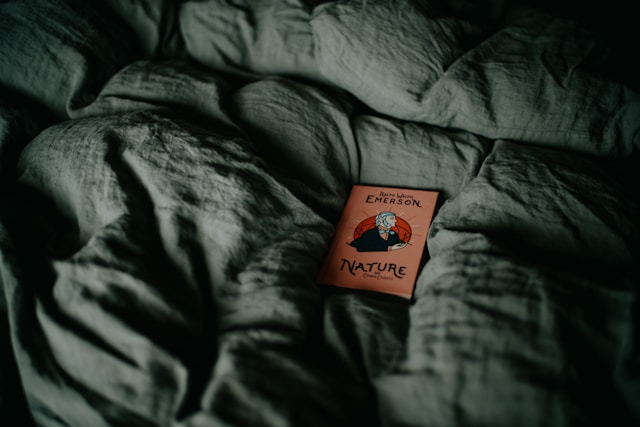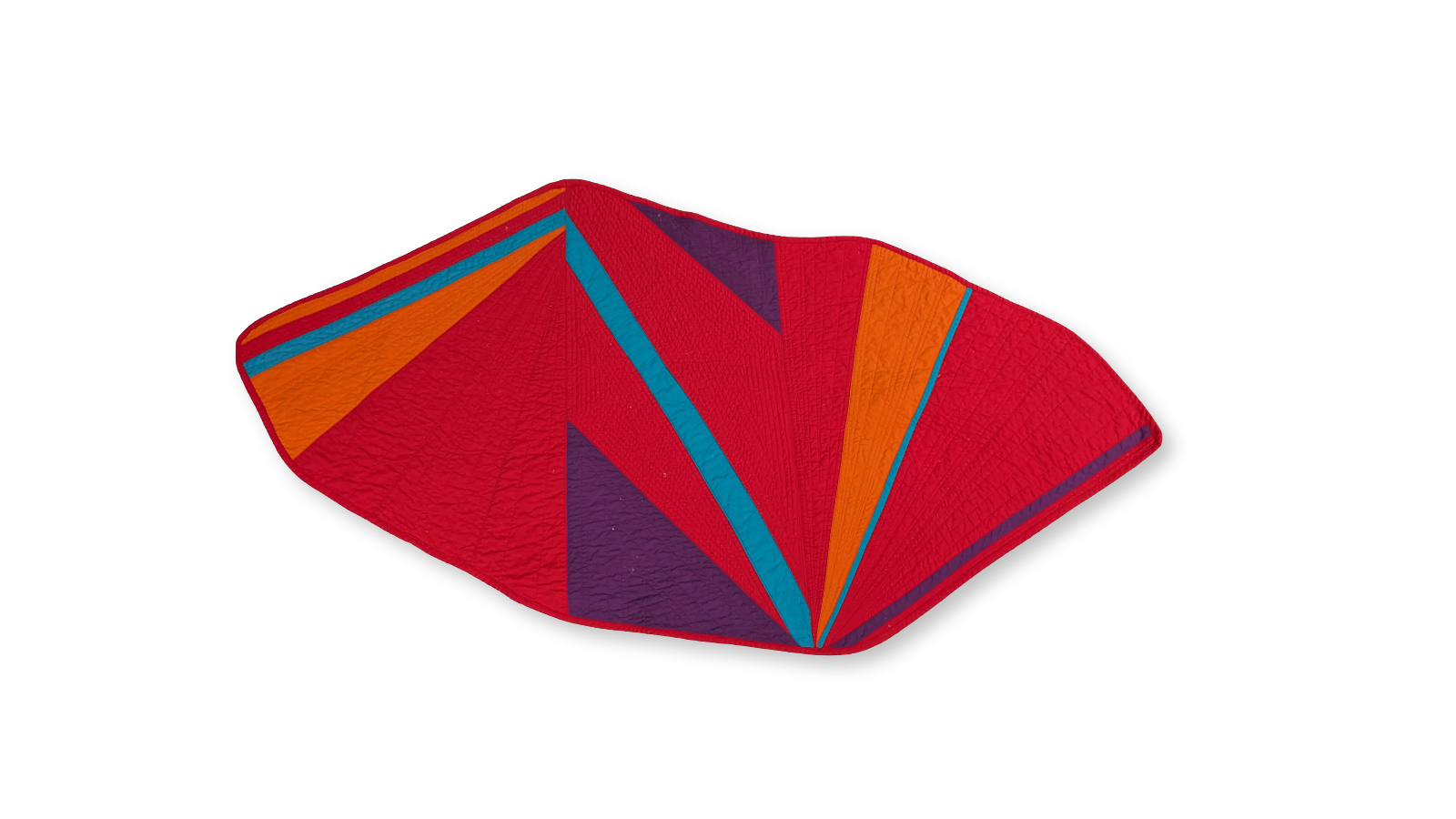The Erotic Life of Log Cabin Quilts

The Bed They Made: Sex, Betrayal, and the Secret History of Rauschenberg and Johns
There is perhaps no object more laden with the mythology of sexless domesticity than the quilt. We imagine them draped over beds in farmhouses, stitched by maiden aunts in church basements, or folded primly in cedar chests awaiting the next generation's need for wholesome warmth. And yet, as literary critic Elaine Showalter observed of the Log Cabin pattern, that most canonical of quilt designs, it "can be read as either phallic or vaginal, depending on whether we see it as a projecting pyramid or a depression."
Reader, I regret to inform you that your grandmother's quilt is horny. And sometimes, it's also heartbroken.
In 1955, Robert Rauschenberg made what would become one of the most important artworks of the twentieth century. He took a quilt, one he had taken from artist Dorothea Rockburne at Black Mountain College, stretched it over a wooden support, added a pillow and sheet, and splattered it all with paint. The work was called "Bed," and art critic Jerry Saltz would later write that it "looks like sheets after lovemaking". As a single bed, it also implies "autoerotic and private desires".
But here's what the museum labels won't tell you: during the years when Rauschenberg was creating "Bed" and his other revolutionary Combines, he was sharing actual bed linens with Jasper Johns. From 1954 to 1961, they were lovers, living and working in adjacent studios on Pearl Street and later Front Street in New York. They had to navigate a homophobic society where same-sex relationships were illegal. As Johns would later recall, they were "each other's main audience" for years.
The quilt that became "Bed" wasn't just any quilt from any bed. It was a witness. It knew things.
The Gallery Owner at the Door
The story of how everything fell apart begins with Leo Castelli's visit to Rauschenberg's studio in 1958. Castelli was there to discuss a planned exhibition for Rauschenberg, but by chance found himself in Johns' flat directly below. There he discovered rooms full of paintings, "years of work never before exhibited," Flags and Targets. Castelli signed Johns immediately and Rauschenberg's planned exhibition was instantly forgotten.
This moment of an art dealer choosing one lover over the other would reverberate through both men's lives and work. Johns' career took off while Rauschenberg watched from the sidelines. The domestic space they had shared, where quilts moved from bed to wall and back again, became a site of professional rivalry that poisoned their personal relationship.
Rauschenberg would later attribute their breakup to the sudden increase in public attention: "What had been tender and sensitive became gossip". But the truth was more bitter. Johns made revenge paintings after their split, including one pointedly titled "Liar." More poignantly, in 1961, as the relationship was ending, Johns titled another painting "In Memory of My Feelings - Frank O'Hara," taking its name from a poem about gay love and the price paid for suppressing it.
The Quilt That Tells the Truth
Thirty-two years later, in 1993, an artist named Chas Marlin created a quilt that said out loud what the art world had been whispering for decades. "Castelli Lovers" uses coded items from the paintings of Rauschenberg and Johns to illustrate their relationship. The target on the left figure's chest is a common motif in Johns' paintings; the quilted bed underneath both figures directly references Rauschenberg's "Bed" Combine. The title refers both to Leo Castelli, the gallery owner who gave Johns his first solo show, and to the two artists' creative and personal relationship.
Marlin's quilt cleverly calls attention to the neglected history of quilts in 20th-century modern art, while acknowledging how Johns and Rauschenberg kept their romantic relationship hidden out of professional and social necessity. It's a quilt about quilts, about the bed that became art, about the love that couldn't speak its name except through coded symbols: targets and beds, flags and combines.
But even this act of truth-telling through textile has been suppressed. The history of quilt censorship in America is long and specifically targeted at works that address LGBTQ themes. In 1994, Jonathan Shannon's "Amigos Muertos," commemorating artists who died from AIDS, was banned from the American Quilter's Society after he had become the first male to win their "Best of Show" award the previous year. The pattern continues: quilts that speak about bodies, about desire, about loss from AIDS, about women's bodies and reproductive rights become the quilts that get hidden away, removed from exhibitions, deemed inappropriate.
Every Quilt Knows What the Bed Has Seen
The NAMES Project AIDS Memorial Quilt understood what "Castelli Lovers" knew, what Rauschenberg's "Bed" knew: that textiles are witnesses. They absorb our lives. Our sweat, our tears, our blood, our sex. When we transform them into art, they carry those histories with them, whether we acknowledge them or not.
Judith Helen Elsley, in her dissertation on the semiotics of quilting, positions quilts as "discourse of the marginalized," a way for those without access to traditional forms of power to speak. But what happens when that speech is about love between men, made literal in the transformation of their actual bedding into one of the most famous artworks of the twentieth century?
Critics at the time saw violence in "Bed." One reviewer claimed it "recalls a police photo of the murder bed after a corpse has been removed." But Rauschenberg himself insisted: "I think of Bed as one of the friendliest pictures I've ever painted. My fear has always been that someone would want to crawl into it".
Someone had crawled into it. Jasper Johns had. And when Leo Castelli came knocking, when success beckoned from downstairs, when the art world demanded its new star, the bed was unmade. The relationship ended. The quilt remained, suspended on a gallery wall, paint-splattered and permanent, a monument to what had been shared and lost.
The Quilts We Make and the Beds We Lie In
Contemporary quilt artist Zak Foster and others now create quilts explicitly inspired by sex, refusing the traditional dichotomy between the chaste domestic sphere and the erotic imagination. The blog Bad Ass Quilter published an article titled "You Can Have Sex On My Quilt," a manifesto acknowledging what we all know but rarely say: quilts are meant to be lived on, loved on, and yes, fucked on.
As one critic writes of Rauschenberg's "Bed": it is where "intimacy may manifest, where dreams play out, or where fertility—by way of female menstruation—may be registered. It is where one may enter into the humming frenzy of existence, or get swallowed into the dark oblivion of death." The quilt knows all of this. It has always known.
But the most profound statement might be Marlin's "Castelli Lovers," which takes the entire history (the quilt that became "Bed," the love affair that changed American art, the betrayal that ended it) and stitches it back together in fabric. It's a quilt that remembers what others would prefer to forget: that behind every Flag and Target, every Combine and assemblage, were two men who gave each other permission to make art, who were each other's audience before they had any other, who shared beds and studios and ideas until a gallery owner's choice tore it all apart.
The quilt in Rauschenberg's "Bed" is owned by MoMA now, professionally conserved, climate-controlled, behind barriers and in storage. Thousands of visitors see it each year via their website. Most don't know it witnessed the most important love affair in American art, that it became famous at the precise moment that affair was ending.
The museum label mentions the technique, the sheet, the paint. It let's the artist claim “It was very simply put together, because I actually had nothing to paint on. Except it was summertime, it was hot, so I didn’t need the quilt." Sure Robert, sure.
It doesn't mention that this was a real bed that real people slept in, loved in, fought in. It doesn't mention that when we make a bed into art, we're also making art of everything that happened in that bed.
Showalter was right about the Log Cabin pattern. It can be read as either phallic or vaginal, depending on how we see it. But she might have gone further: every quilt can be read as either hiding or revealing, either covering or exposing. The genius of Rauschenberg's "Bed" wasn't just that he put a quilt on the wall. It was that he showed us what quilts have always known: that the most intimate spaces of our lives are already art, already political, already public even when we pretend they're private.
And sometimes, when a dealer comes to your lover's door and chooses him over you, the bed you shared becomes one of the most famous artworks you will ever make. It becomes a monument to what was loved and lost, stitched and torn, hidden in plain sight on the gallery wall.
After all, what is a quilt but a map of human need, stitched together one urgent piece at a time? And what is betrayal but another pattern we know by heart? The wedding ring that becomes a target, the log cabin that becomes a trap, the bed that becomes a coffin for a love that couldn't survive its own success.

